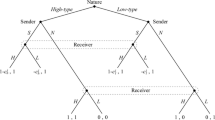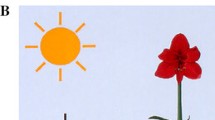Abstract
We discuss how the theoretical framework related to selection pressures on multi-component and multi-modal signalling introduced by the article of Wilson et al. in this special issue could usefully be built both theoretically and empirically. Theoretically, we suggest that the game theory approach of Wilson et al. could be generalised using the methodology of adaptive dynamics in order to indicate evolutionary trajectories and paths of evolution. This might indicate the relative likelihood of finding different equilibriums empirically in situations where the game theory explorations of Wilson et al. suggest that multiple equilibriums may exist for a given system. We also suggest how the work of Wilson et al. could be extended theoretically and empirically to further capture the effects of receiver psychology on selective pressures on multi-component and multi-modal signals. We also highlight the assumptions and predictions of the existing theory that would most benefit from and would be most amenable to empirical testing.
Similar content being viewed by others
References
Blount JD, Speed MP, Ruxton GD, Stephens PA (2009) Warning displays may function as honest signals of toxicity. Proc R Soc Lond B 276:871–877
Bradbury JW, Vehrencamp SL (1998) Principles of animal communication. Sinauer Associates, Sunderland
Bro-Jörgensen J (2010) Dynamics of multiple signaling systems: animal communication in a world in flux. Trend Ecol Evol 25:292–300
Broom M, Rychtar J (2013) Game theoretical models in biology. Chapman & Hall, New York
Candolin U (2003) The use of multiple cues in mate choice. Biol Rev 78:575–595
Chaine AS, Lyon BE (2008) Adaptive plasticity in female mate choice dampens sexual selection on male ornaments in the lark bunting. Science 319:459–462
Dercole F, Rinaldi S (2008) Analysis of evolutionary processes: the adaptive dynamics approach and its applications. Princeton University Press, Princeton
Emlen DJ, Warren IA, Johns A, Dworkin I, Lavine LC (2012) A mechanism of extreme growth and reliable signaling in sexually selected ornaments and weapons. Science 337:860–864
Engers M (1987) Signalling with many signals. Econometrica 50:1431–1451
Hansen DM, Olesen JM, Mione T, Johnstone SD, Muller CB (2007) Coloured nectar: distribution, ecology and evolution of an enigmatic floral traits. Biol Rev 82:83–111
Hebets EA, Papaj DR (2005) Complex signal function: developing a framework of testable hypotheses. Behav Ecol Sociobiol 57:197–214
Hurd PL, Enquist M (2005) A strategic taxonomy of biological communication. Anim Behav 70:1155–1170
Krakauer DC, Johnstone RA (1995) The evolution of exploitation and honesty in animal communication: a model using artificial neural networks. Philos T Roy Soc B 348:355–361
Kulahci IG, Dornhaus A, Papaj DR (2008) Multimodal signals enhance decision making in foraging bumble-bees. Proc R Soc Lond B 275:797–802
Partan S, Marler P (1999) Communication goes multimodal. Science 283:1272–1273
Ramey G (1996) DI signalling equilibria with multiple signals and a continuum of types. J Econ Theory 69:508–531
Rowe C, Halpin C (2013) Why are warning signals multimodal? Behav Ecol Sociobiol. doi:10.1007/s00265-013-1515-8
Ruxton GD (2009) Non-visual crypsis: a review of the evidence for camouflage to senses other than vision. Philos T Roy Soc Lond B 364:549–557
Schaefer HM, Ruxton GD (2012) By-product information can stabilize the reliability of communication. J Evol Biol 25:2412–2421
Schaefer HM, Schaefer V, Levey DJ (2004) How plant–animal interactions signal new insights in communication. Trends Ecol Evol 19:577–584
Speed MP, Ruxton GD, Mappes J, Sherratt TN (2012) Why are defensive toxins so variable? An evolutionary perspective. Biol Rev 87:874–884
Spence M (1973) Job market signalling. Q J Econ 87:355–374
Stevens M (2013) Sensory ecology, behaviour and evolution. Oxford University Press, Oxford
Stournaras KE, Lo E, Böhning-Gaese K, Cazetta E, Dehling DM, Schleuning M, Stoddard MC, Donoghue MJ, Prum RO, Schaefer HM (2013) How colorful are fruits? Limited color diversity in fleshy fruits on local and global scales. New Phytol 198:617–629
Uy JAC, Safran RJ (2013) Variation in the temporal and spatial use of signals and its implications for multimodal communication. Behav Ecol Sociobiol (in press)
Wilson AJ, Dean M, Higham JP (2013) A game theoretic approach to multimodal communication. Behav Ecol Sociobiol (in press)
Acknowledgments
We thank Eileen Hebets, James Higham and two anonymous referees for their valuable comments on earlier versions.
Author information
Authors and Affiliations
Corresponding author
Additional information
Communicated by J. P. Higham
This manuscript is part of the special issue Multimodal Communication – Guest Editors: James P. Higham and Eileen A. Hebets
Rights and permissions
About this article
Cite this article
Ruxton, G.D., Schaefer, H.M. Game theory, multi-modal signalling and the evolution of communication. Behav Ecol Sociobiol 67, 1417–1423 (2013). https://doi.org/10.1007/s00265-013-1596-4
Received:
Revised:
Accepted:
Published:
Issue Date:
DOI: https://doi.org/10.1007/s00265-013-1596-4




